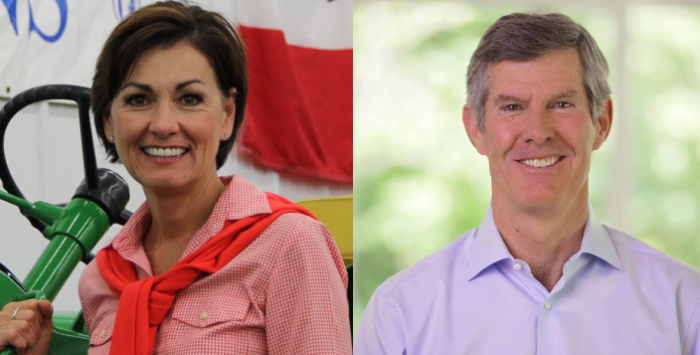Earlier this year, Kim Reynolds wasn’t widely seen as one of the country’s most vulnerable Republican governors. But she trails Fred Hubbell in the most widely respected Iowa poll, and Democrats have built up a larger advantage in early votes than the party had going into the last midterm election.
Democrats should not be complacent, though. The governor’s race still looks more like a toss-up than a campaign with a clear favorite.
The Des Moines Register always publishes a poll of Iowa’s top race on the Saturday night before election day, and Ann Selzer’s reputation as the “best pollster in politics” makes that final Register poll more influential than any other Iowa survey. Democratic morale was crushed the weekend before the 2014 election, when Selzer found U.S. Senate candidate Joni Ernst 7 points ahead of Bruce Braley and declared on the front page of the Sunday paper, “This race looks like it’s decided.”
In contrast, the new survey for the Des Moines Register and Mediacom shows a tight race: 46 percent of respondents back Hubbell, 44 percent Reynolds, 2 percent Libertarian Jake Porter, 2 percent are undecided. The two-point lead is within the margin of error for the poll of 801 likely voters from October 30 through November 2.
Top Reynolds strategist David Kochel has indulged in some chest-beating lately about supposedly crumbling Democratic poll numbers in Iowa. No such trend is apparent in Selzer’s research. The Register’s survey from mid-September also showed Hubbell two points ahead.
Brianne Pfannenstiel reported on notable findings from the new survey:
Hubbell leads among women (52 percent to 39 percent), independents (45 percent to 39 percent), and Catholics (47 percent to 41 percent), as well as “among those who align with no religion, those with incomes less than $50,000, those under 35 or 65 and older and with city dwellers.”
Reynolds leads among men (50 percent to 40 percent) and “does best with those earning incomes of more than $70,000, with Protestants and evangelicals and with those who live in towns.” A plurality rated her more highly on most of the leadership qualities tested, though those margins were all small, between 1 and 6 points.
Both candidates have support from about 90 percent of respondents who identify with their political party. They are also in positive territory on favorability: 54 percent favorable/41 percent unfavorable for Reynolds, and 53 percent favorable/38 percent unfavorable for Hubbell.
These data points seem particularly important:
Fifty percent of likely voters agree with [Reynolds] that things in Iowa are headed in the right direction, including 87 percent of those who say they’re backing her for governor. […]
Forty-three percent, including 79 percent of Hubbell supporters, say the state is on the wrong track. […]
Independents are nearly evenly split on the state’s direction, with 46 percent saying things are going well and 47 percent who say the state is on the wrong track. […]
Among likely voters, 61 percent say they’d like to make a change from the path Branstad charted for the state, while 34 percent say they’d like to see Iowa stay the course. Five percent aren’t sure.
Reynolds has been adamant all year: she will “Keep Iowa Moving” in the right direction, while Hubbell will take the state backwards. She’s delivered that message in many radio and television commercials and in all three debates (see here, here, and here).
If a clear majority of Iowa voters want state government to change course, then “things are great, and we’re just getting started” won’t be a compelling case.
On a related note, if Selzer’s findings are accurate and independents are tilting toward Hubbell, then he will likely go into election day with a substantial lead among Iowans who have already voted. As of November 2, registered Democrats had cast about 35,000 more ballots than Republicans. County auditors had also received some 90,000 ballots from no-party voters.
A quick word about two other polls of the governor’s race, which were released on November 2. Emerson Polling found Reynolds leading Hubbell by 49 percent to 45 percent. The same pollster found Hubbell ahead by 36 percent to 31 percent in early September.
Emerson uses a strange methodology, combining an online sample with respondents who have landlines, drawn from a voter file. They don’t appear to sample voters with only cellphones, which seems like a big problem. FiveThirtyEight’s pollster ratings give Selzer an A+ and Emerson a B+.
The latest University of Iowa Hawkeye Poll indicated that 43.6 percent of respondents back Hubbell, 40.0 percent Reynolds, 6.3 percent other candidates, and 10.1 percent undecided. But that survey was in the field for two full weeks, and the sampling period ended on October 22. If the University of Iowa wants the Hawkeye Poll to be impactful, the students and faculty who conduct it need to find some way to get the results out more quickly. However interesting the findings are, a survey based on weeks-old data will never be as useful as a fresh poll.
Final note: Reynolds brought in Ivanka Trump for a couple of small campaign events on November 1 and 2. I don’t understand who was supposed to be the target audience. Was the idea to improve the governor’s standing with women and moderates, or to fire up fans of President Donald Trump who might not otherwise be inspired to turn out?


1 Comment
6% "someone else/refuse to answer" seems high for this point..
Porter is at 2%; he was at 7% in September, I wonder if some of the “someone else” are potential LP voters not recognizing the LP candidate name. I cant imagine anyone else getting 1%, so the unknown amount of that 6% (in addition to the clear 2% undecideds) seems like it adds even more uncertainty either way.
lime Sun 4 Nov 8:23 AM